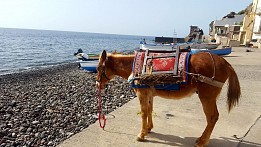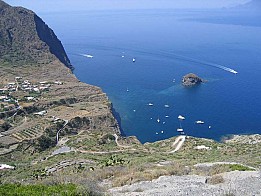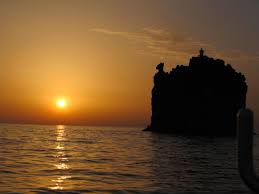The Panarea colors are white lime walls of the houses and the turquoise of its waters. Panarea was once one of the largest of the Aeolian Islands, but after natural disasters volcano is partially collapsed, so that the inside of the crater original amphitheater has become the coast where there are the three villages of Iditella, St. Peter and Drautto. This area takes its name from the Saracen pirate Drauth, who used to moor his just south ships in nearby Cala Junco, one of the most beautiful bays in the Mediterranean; it is a kind of natural pool, enclosed by high walls of basaltic rocks, where the vain sea interprets the colors of which it is capable, giving us all the crystal clear shades of green, turquoise and blue.
The high cliffs that surround the creek do not allow boaters to see the inside of the bay and the pirate Drauth could therefore suddenly surprise the passing ships that were heading from northern Italy to Sicily.
What remains of the sunken part of the original volcano of Panarea, it is now made up of a myriad of rocks and islets that surround almost an "archipelago in the archipelago" to visit by extreme attention to the rocks.
It starts from Dattilo, with its sulfur caves and alum crystallized. It continues with the small island of Basiluzzo, now uninhabited, with sheer drops to the sea and almost inaccessible, where lie the remains of an ancient Roman villa and the adjacent rock Spinazzola, tall almost 80 meters., All spiers and vertical walls; Here is an endemic colony of dwarf palm trees, unique in Europe. Farther south are the rocks of Lisca Nera, Bottaro and Lisca Bianca: the latter, applying for the castings of pumice, has within it the little Grotta degli innamorati, where legend has it that anyone who kisses will remain united forever. Twenty meters underground, in the sea area between the three rocks, the bubbling water of hundreds of columns of bubbles: you are in fact at the center of the original volcano, apparently not yet fully switched off.
Another endogenous event can be found on the north east coast, in the locality of Calcara, where there are hot springs and fumaroles that emit carbon dioxide, nitrogen and oxygen. Panarea has not yet completed its process of collapse: the island plunges to two centimeters every year; there is still time, however, to visit this little paradise without cars, where we rediscover the pleasure of walking to the discovery of tiny alleys between the white houses of lime and enchanting views of rocks and islets that make up the frame.


















